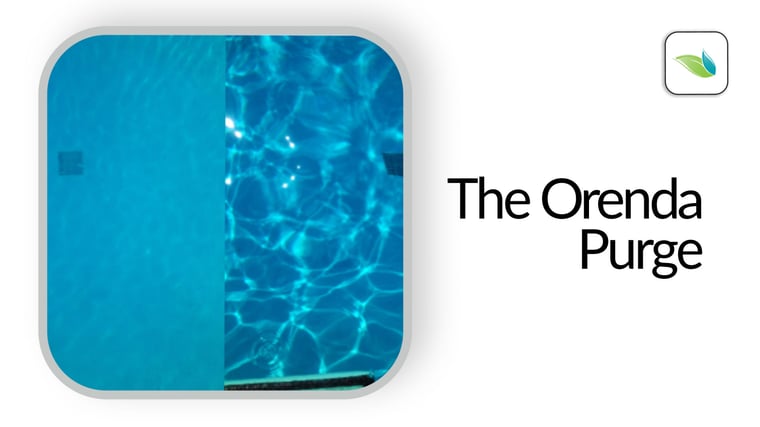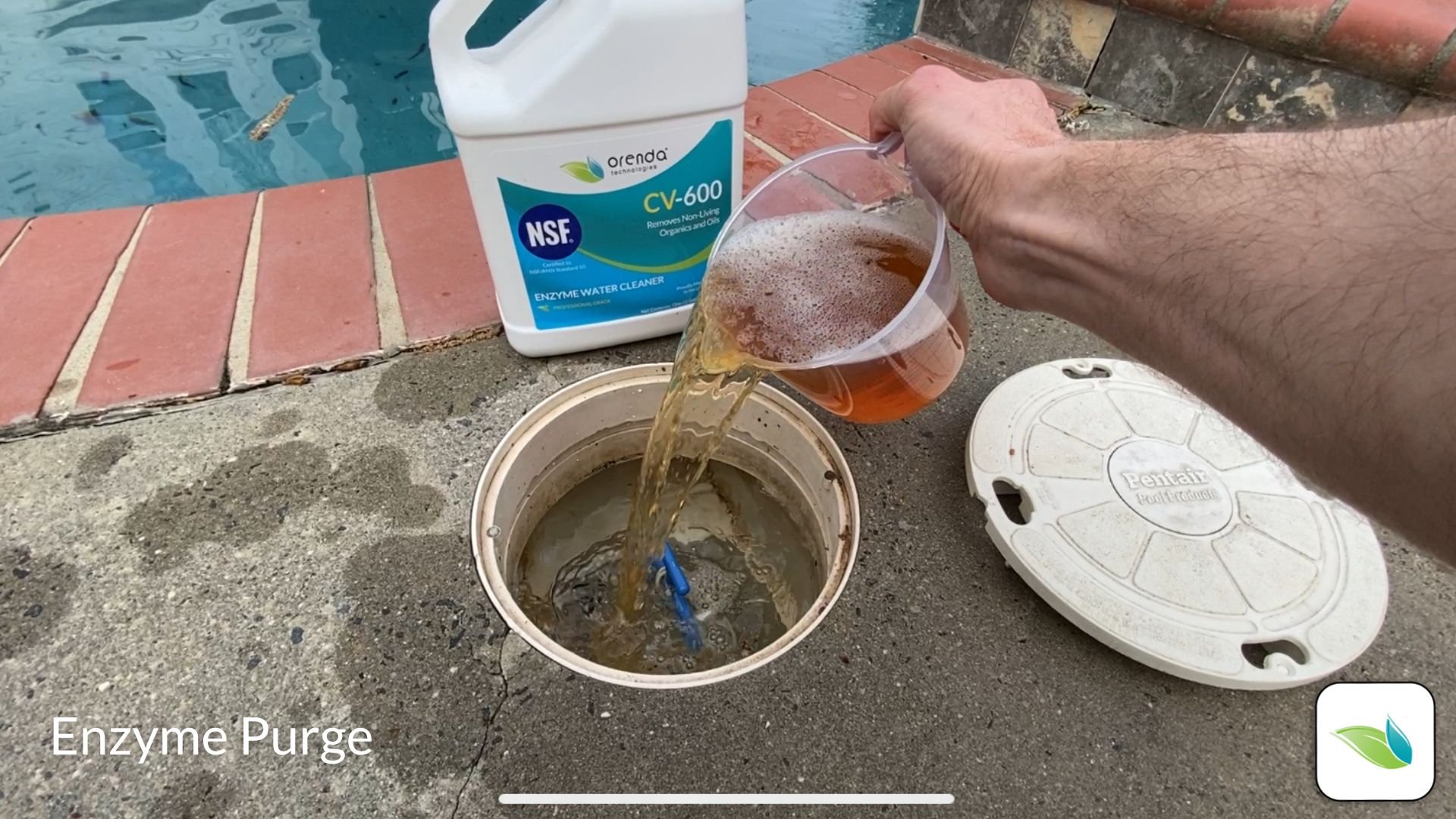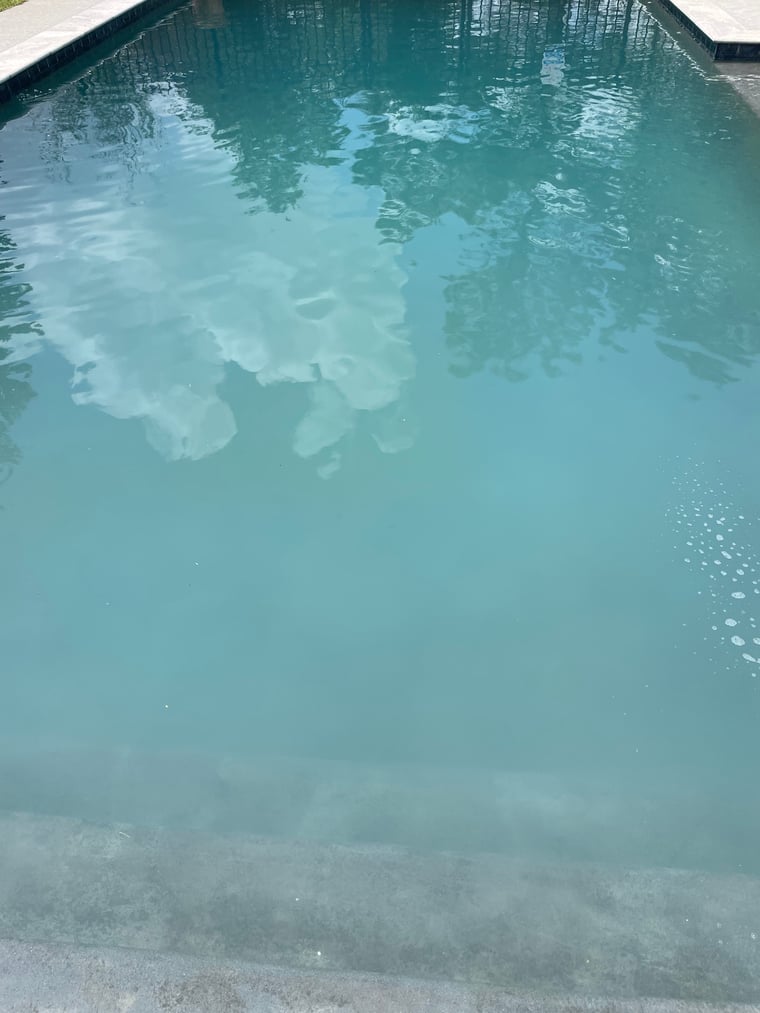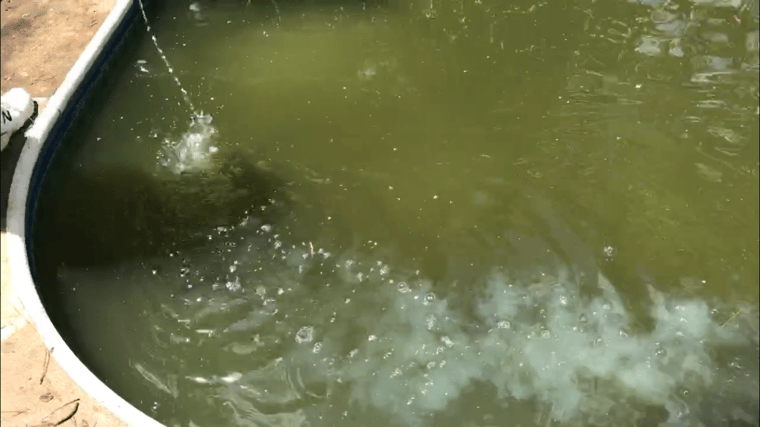The Orenda Purge

When first using Orenda products like SC-1000 and CV-600/700, the initial dose is called the purge dose. So what is a purge? And why is it necessary? This article will explain.
Covered in this article:
What is a purge dose?

A purge dose of Orenda chemicals is the initial dose to overpower the targeted oxidant demand and/or metals and minerals, then leave a residual for the future. An Orenda purge is usually one quart per ten thousand gallons (32 fl.oz./10,000 gallons).
Let's use CV-600 enzymes as an example. The CV-600 purge puts enough enzymes in circulation to not only clean the water, but also leave behind a residual. The water benefits from an enzyme residual to keep up with the bather demand. Enzymes are far more efficient at removing non-living organics and oils than chlorine alone.
How long does the purge dose last?
The purge dose of enzymes should last for a few weeks, and SC-1000 Scale & Metal Control can last even longer. That said, these products get used up doing their job, so the water needs a maintenance dose of a few ounces per week, depending on the bather load. For pools serviced weekly, once a week is fine. For commercial pools, we strongly suggest dividing the weekly maintenance dose over several days a week. Most commercial customers use a feed pump, and most residential customers use a measuring cup.
The process is simple: purge at the beginning of the season, then add the weekly maintenance dose to replenish and maintain the residual.
Why is purging necessary?
Orenda chemicals address specific problems, but not every problem. SC-1000 chelates metals (including calcium, an alkali earth metal) to prevent stains, metal oxidation, and carbonate scale. CV-600 and CV-700 enzymes break down and remove non-living organics like bather waste. This waste spreads around in the water but usually floats up near the surface (because oils are less dense and do not dissolve in water).
Related: Why is a purge dose necessary?
Think about it. Metals are in solution or suspension, and bather waste is constantly being introduced into the water. Point-of-contact systems like UV, ozone, and AOP are only effective when water passes through them. But non-living organics and metals are out in the pool where people are...and that's where Orenda products need to be too, right alongside residual chlorine.
Without a purge dose, the existing demand may not be completely addressed, and you may not get ahead of the problem. For example, if you only chelate 70% of the metals in your water...that still leaves behind 30% of the metals in your water that will be oxidized by chlorine, and that 30% could be plenty to leave stains or change the color of your water. It's not that SC-1000 failed; it's that there was not enough of it to cover the demand. The same can happen with enzymes when customers start with the weekly maintenance dose and do not purge.
Weekly Maintenance Dose
Enzymes eventually get used up removing carbon-based waste (non-living organics), just like SC-1000 gets used up chelating metals (including calcium). After the purge, the weekly maintenance dose replenishes what has been used.
The weekly maintenance dose is important because tap water and bather loads can introduce new metals and organics. Fortunately, Orenda maintenance doses are usually small and affordable. It all depends on your pool and its needs. If your pool has special needs, contact us, and we will help you create a custom dosing program.
Here is a table showing purge and maintenance doses for two Orenda products.
Orenda Dosing Chart, per 10,000 gallons of water
| Product | Purge Dose |
Residential Maintenance |
Commercial Maintenance |
| CV-600 / CV-700 Enzymes | 32 fl.oz. (one quart) | 5 fl.oz. per week | 10 fl.oz. per week |
| SC-1000 Scale & Metal Control | 32 fl.oz. (one quart) | 3 fl.oz. per week | 3 fl.oz. per week |
You may notice our phosphate remover, PR-10,000, is not on this chart. That's because PR-10,000 does not leave behind a residual. Phosphate removal is a one-and-done reaction, designed to work quickly and fall out of solution. We recommend using it as needed unless your pool is in really bad shape or has very high phosphates (several thousand parts per billion). If so, follow the dosing instructions on the bottle or in our help article: How to use PR-10,000.
Breaking bad water

Sometimes the situation is severe, like a pool cloudy enough that you cannot see the main drain at the bottom. In such cases, you may need to break the water. There is an abundance of oxidant and/or sanitizer demand that chlorine is overwhelmed trying to get rid of. There could also be a filtration and circulation problem.
Start by checking the filter for problems (cartridges could be clogged up or torn, DE filters could have broken grids, and sand filters could be channeling). If you have ruled out the filter as part of the issue, we can usually turn the pool around chemically by directly removing the contaminants themselves. The main culprits? You guessed it: non-living organics and phosphates.
Such pools may need 16, 24 or even 32 fl.oz. of PR-10,000 per 10,000 gallons, along with the purge dose of CV-600 or CV-700. We have nicknamed this heavier dose "The Orenda Bomb".
Breaking the water requires both CV-600/700 enzymes AND PR-10,000. Used alone, both will help, but may not completely get you where you could be. It's important to note that oils and organics float, while dust/dirt/debris sink. If something sinking touches a sticky oil floating, the particle becomes suspended in the water and is hard to clear. The result is phosphate dust and debris that will take longer to fall to the floor for vacuuming. Enzymes, however, remove those oils. The pool should be clear within 24 hours.
Remember that breaking the water is a reactive treatment, not a proactive one. It fixes a problem that was already lurking in the water. If you maintain your pool as an Orenda pool year-round, you should not have to break it again.
Example Purge Situations
There are many instances where an Orenda purge can help a pool, and below are just three common examples. The most common timing for a purge, however, is when you open your pool in the spring.

- Green Pool from Algae: No Orenda product will kill the algae, so you will need to shock with unstabilized chlorine, and lower the pH. Drop the pH to about 7.4, and shock with liquid chlorine (sodium hypochlorite) or cal hypo (calcium hypochlorite). Algaecide is not necessary because chlorine is the best algaecide. We immediately follow the chlorine shock with one quart per 10,000 gallons (32 fl.oz./10,000 gallons) of PR-10,000 phosphate remover. Then purge with 32 fl.oz./10,000 gallons of CV-600 enzymes. The next day the water should be clear, but debris on the floor. Then, physically clean up the pool: vacuum to waste, and clean the filter. Read our detailed Green Pool Cleanup Procedure to learn more.
- Cloudy, dirty water: Purge with CV-600 enzymes and 16 fl.oz./10,000 gallons of PR-10,000. If you want, you can follow it up with some CE-Clarifier for larger particles that may be floating around. If its so severe that you cannot see the bottom, do the "Orenda Bomb" and put in 24-32 fl.oz. of PR-10,000 per 10,000 gallons in tandem with the enzyme purge.
- Carbonate scale: Purge with SC-1000 and raise the water level enough to soak the affected tile line as much as possible. Keep water circulating, and since SC-1000 can deplete chlorine levels for a day or so, manually feed chlorine as needed. Continue maintaining 3 fl.oz./10,000 gallons per week until the scale has softened enough to be removed. Read our procedure for How to Soften and Remove Scale to learn more.
